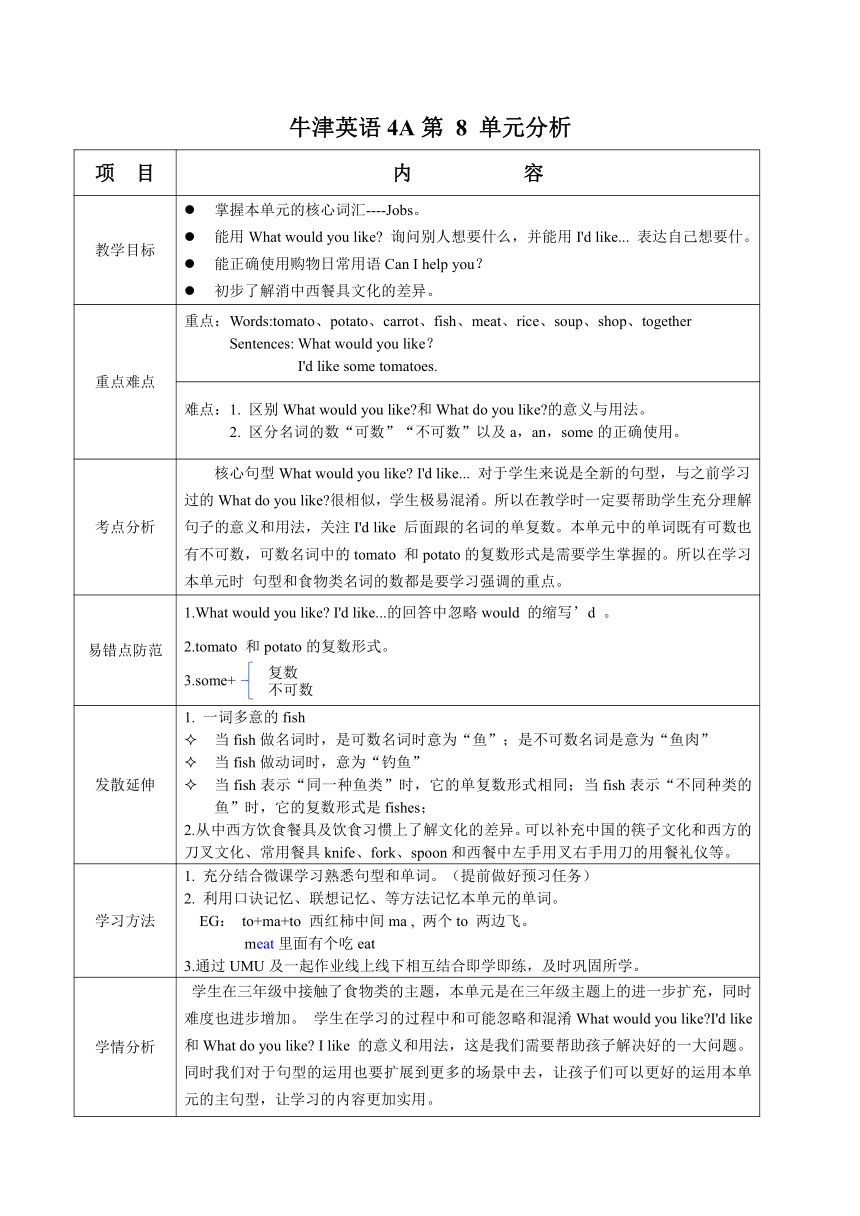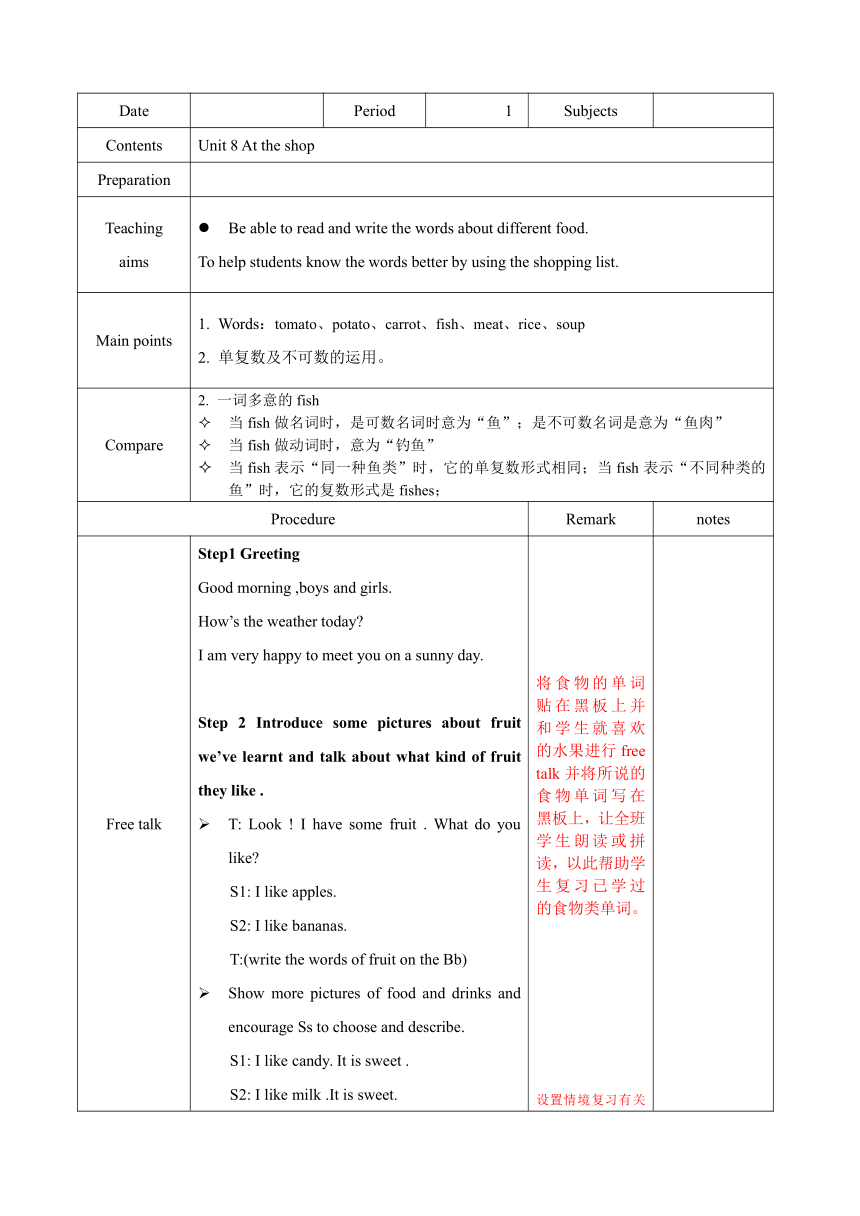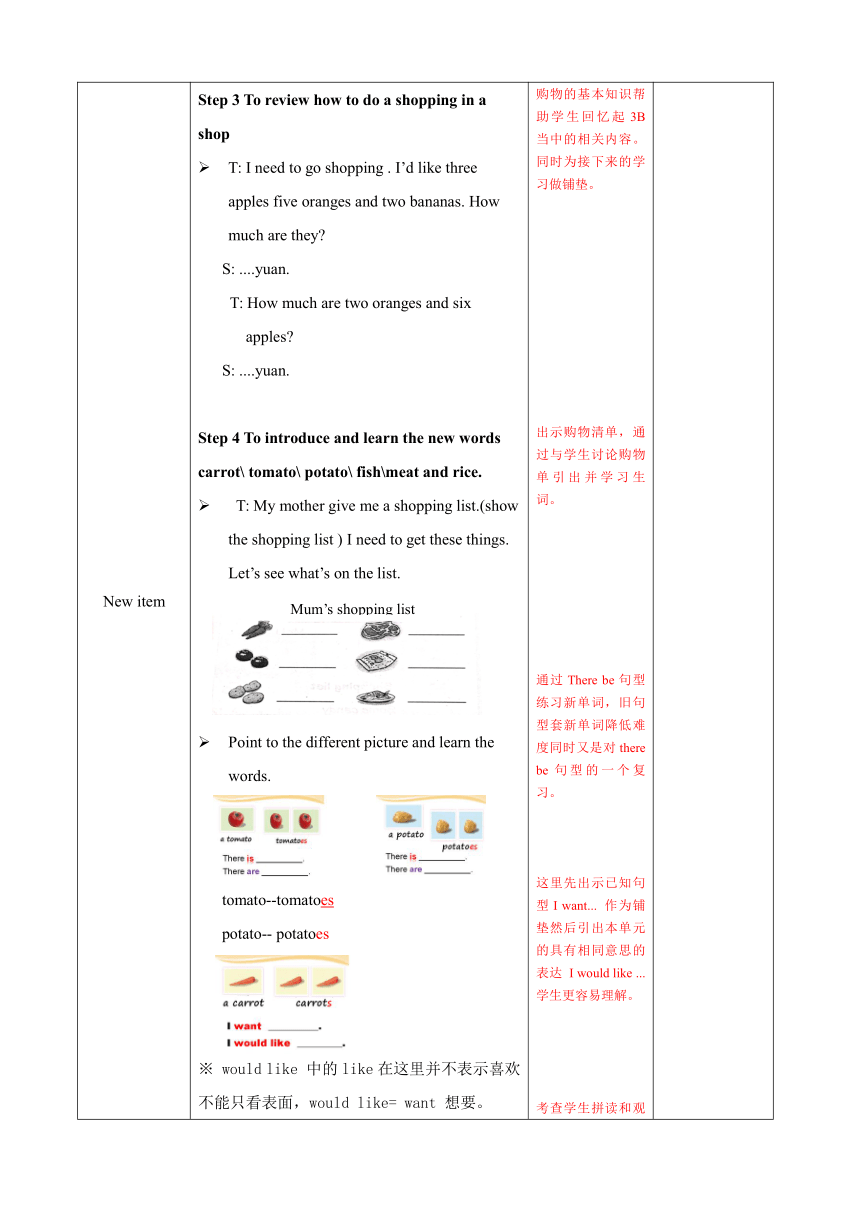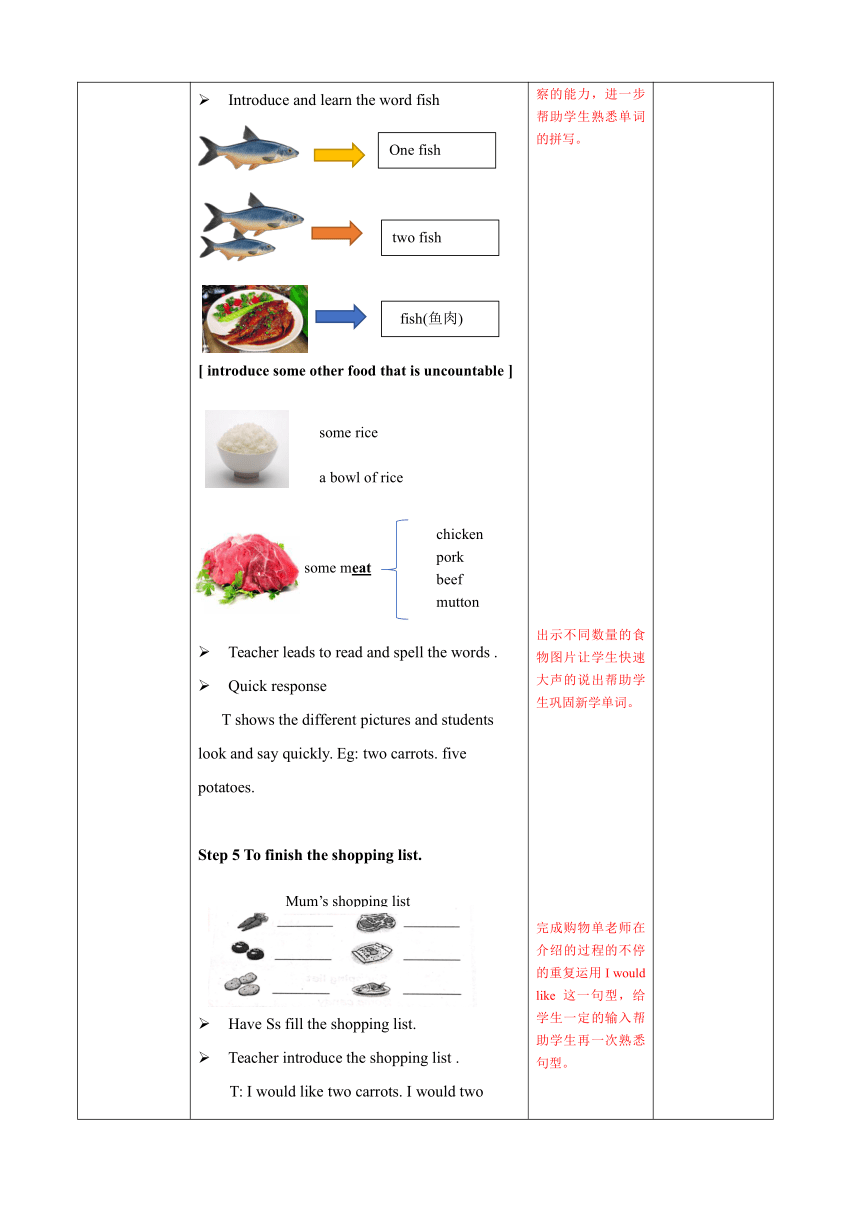Unit 8 At the shop 电子教案
文档属性
| 名称 | Unit 8 At the shop 电子教案 |  | |
| 格式 | zip | ||
| 文件大小 | 2.3MB | ||
| 资源类型 | 教案 | ||
| 版本资源 | 牛津深圳版 | ||
| 科目 | 英语 | ||
| 更新时间 | 2019-09-01 09:52:08 | ||
图片预览





文档简介
牛津英语4A第 8 单元分析
项 目 内 容
教学目标 掌握本单元的核心词汇----Jobs。 能用What would you like? 询问别人想要什么,并能用I'd like... 表达自己想要什。 能正确使用购物日常用语Can I help you? 初步了解消中西餐具文化的差异。
重点难点 重点:Words:tomato、potato、carrot、fish、meat、rice、soup、shop、together Sentences: What would you like? I'd like some tomatoes.
难点:1. 区别What would you like?和What do you like?的意义与用法。 区分名词的数“可数”“不可数”以及a,an,some的正确使用。
考点分析 核心句型What would you like? I'd like... 对于学生来说是全新的句型,与之前学习过的What do you like?很相似,学生极易混淆。所以在教学时一定要帮助学生充分理解句子的意义和用法,关注I'd like 后面跟的名词的单复数。本单元中的单词既有可数也有不可数,可数名词中的tomato 和potato的复数形式是需要学生掌握的。所以在学习本单元时 句型和食物类名词的数都是要学习强调的重点。
易错点防范 1.What would you like? I'd like...的回答中忽略would 的缩写’d 。 2.tomato 和potato的复数形式。 3.some+
发散延伸 一词多意的fish 当fish做名词时,是可数名词时意为“鱼”;是不可数名词是意为“鱼肉” 当fish做动词时,意为“钓鱼” 当fish表示“同一种鱼类”时,它的单复数形式相同;当fish表示“不同种类的鱼”时,它的复数形式是fishes; 2.从中西方饮食餐具及饮食习惯上了解文化的差异。可以补充中国的筷子文化和西方的刀叉文化、常用餐具knife、fork、spoon和西餐中左手用叉右手用刀的用餐礼仪等。
学习方法 充分结合微课学习熟悉句型和单词。(提前做好预习任务) 利用口诀记忆、联想记忆、等方法记忆本单元的单词。 EG: to+ma+to 西红柿中间ma , 两个to 两边飞。 meat里面有个吃eat 3.通过UMU及一起作业线上线下相互结合即学即练,及时巩固所学。
学情分析 学生在三年级中接触了食物类的主题,本单元是在三年级主题上的进一步扩充,同时难度也进步增加。 学生在学习的过程中和可能忽略和混淆What would you like?I'd like 和What do you like? I like 的意义和用法,这是我们需要帮助孩子解决好的一大问题。同时我们对于句型的运用也要扩展到更多的场景中去,让孩子们可以更好的运用本单元的主句型,让学习的内容更加实用。
Date Period 1 Subjects
Contents Unit 8 At the shop
Preparation
Teaching aims Be able to read and write the words about different food. To help students know the words better by using the shopping list.
Main points Words:tomato、potato、carrot、fish、meat、rice、soup 单复数及不可数的运用。
Compare 一词多意的fish 当fish做名词时,是可数名词时意为“鱼”;是不可数名词是意为“鱼肉” 当fish做动词时,意为“钓鱼” 当fish表示“同一种鱼类”时,它的单复数形式相同;当fish表示“不同种类的鱼”时,它的复数形式是fishes;
Procedure Remark notes
Free?talk Step1 Greeting Good morning ,boys and girls. How’s the weather today? I am very happy to meet you on a sunny day. Step 2 Introduce some pictures about fruit we’ve learnt and talk about what kind of fruit they like . T: Look ! I have some fruit . What do you like? S1: I like apples. S2: I like bananas. T:(write the words of fruit on the Bb) Show more pictures of food and drinks and encourage Ss to choose and describe. S1: I like candy. It is sweet . S2: I like milk .It is sweet. 将食物的单词贴在黑板上并和学生就喜欢的水果进行free talk并将所说的食物单词写在黑板上,让全班学生朗读或拼读,以此帮助学生复习已学过的食物类单词。 设置情境复习有关购物的基本知识帮助学生回忆起3B当中的相关内容。同时为接下来的学习做铺垫。 出示购物清单,通过与学生讨论购物单引出并学习生词。 通过There be句型练习新单词,旧句型套新单词降低难度同时又是对there be句型的一个复习。 这里先出示已知句型I want... 作为铺垫然后引出本单元的具有相同意思的表达 I would like ... 学生更容易理解。 考查学生拼读和观察的能力,进一步帮助学生熟悉单词的拼写。 出示不同数量的食物图片让学生快速大声的说出帮助学生巩固新学单词。 完成购物单老师在介绍的过程的不停的重复运用I would like 这一句型,给学生一定的输入帮助学生再一次熟悉句型。 鼓励学生在小组里制作简单的购物清单并用句型I would like ... 进行练习
New item Step 3 To review how to do a shopping in a shop T: I need to go shopping . I’d like three apples five oranges and two bananas. How much are they? S: ....yuan. T: How much are two oranges and six apples? S: ....yuan. Step 4 To introduce and learn the new words carrot\ tomato\ potato\ fish\meat and rice. T: My mother give me a shopping list.(show the shopping list ) I need to get these things. Let’s see what’s on the list. Point to the different picture and learn the words. tomato--tomatoes potato-- potatoes ※ would like 中的like在这里并不表示喜欢不能只看表面,would like= want 想要。 Introduce and learn the word fish [ introduce some other food that is uncountable ] some rice a bowl of rice some meat Teacher leads to read and spell the words . Quick response T shows the different pictures and students look and say quickly. Eg: two carrots. five potatoes. Step 5 To finish the shopping list. Have Ss fill the shopping list. Teacher introduce the shopping list . T: I would like two carrots. I would two tomatoes and three potatoes. I would like some meat and rice. I also would like one fish. Step 6 Sentence drill T:(Show the picture of my dinner )This is my dinner. What do I have for dinner? S: ...... T: What would you like for dinner? Make a simple shopping list in groups and then invite some groups come to the front and show.
Summary We know some words of food. Some of them are countable and some of them are uncountable. We must be careful when we use them. Now let’s read and spell then again. Remark 再次巩固本节课单词 notes
Blackboard Design Unit 8 At the shop
Date Period 2 Subjects
Contents Unit 8 At the shop
Preparation
Teaching aims Be able to find out what other people want with the sentence patterns -What would you like? - I’d like some.... Be able to read and understand the dialogue of “Listen and say”
Main points would like 的读音及理解,学生在读would like的缩写时很容易忽略’d. 单复数及不可数的运用。
Compare would like和 want I would like常常要比 I want更有礼貌。
would you like?要比do you want?更有礼貌,也更殷勤。
Procedure Remark notes
Free?talk Step1 Greeting& quickly response Good morning ,boys and girls. Nice to see you again. --What can you do? --I can... --Can you ...? Yes, I can. No, I can’t. Step 2 Review the words about food. Flash cards and Ss say the word quickly. Stick all the words on the Bb and one minute for Ss to spell and familiar the words. Then play a word scramble game . Show a picture of a shop and talk about the food they can see in the shop. T: What can you see at the shop? S1: I can see ..... 快速问答调动学生的积极性同时调整孩子的状态为学习做好准备 考查学生拼读和观察的能力,进一步帮助学生熟悉单词的拼写。 通过商店的图片引发讨论,这里涉及的食物不仅是本单元的同时也是为下一环节做铺垫。 观看微课,了解熟悉句型在不同场景下该如何运用。 视频中出现的是I’d like 在这里可以给学生适当解释并强调是would like的缩写并尽量要求学生多跟读几次 练习感知句型 学生在这里可能会出现单复数或不可数名词用错的情况教师要及时纠正。 学习短文设计层次不同的问题助学生进一步理解熟悉课文内容 即学即用,将核心句型和之前学习过的购物场景联系起来帮助孩子们在生活中运用句型。
New item Step 3 Introduce the video to know about shopping . T: Boys and girls , if you have 20 yuan ,what would you buy in the shop ? Before shopping let’s watch a video about shopping together. In a restaurant \KFC What would you like to eat\drink? In a shop\market What would you like? Have Ss take out their shopping we’ve done last lesson and do the sentence drill. T: (show my list ) I would like some milk and bread .What would you like? S1: I’d like some carrots and fish. S2: I’d like some potatoes and an ice-cream. Step 4 Mrs Li and Kitty are shopping at a shop . Let’s listen to the text together and answer the question. Questions: Where are they ? What would they like ? How much are they? To listen again and fill Kitty and her mother’s shopping list. To listen and read sentence by sentence then have a role play in groups . Step 5 Ask and answer Teacher demonstrate first and divided the class in group of six and practice.Then practise according to the pattern below.
Summary Afternoon learning the text we know and practice how to buy something. You can also teach and practise with your parents. Remark 总结今天所学并鼓励孩子们多练习 notes
Blackboard Design Unit 8 At a shop --What would you like? --I ’like..... How much is it\ are they?
Date Period 3 Subjects
Contents Unit 8 At the shop
Preparation
Teaching aims Be able to understand the meaning of the text Be able to read with appropriate pronunciation and intonation.
Main points 1. I’d like .... 2. a pair of glasses
Compare glasses是眼镜和玻璃杯的复数 例:I have a pair of glasses.(眼镜) I have many glasses.(玻璃杯)
glass是玻璃杯的单数 例:I have a glass.
Procedure Remark notes
Free?talk Step1 Greeting & revision Good morning ,boys and girls. How are you today? Flash card to read and spell the words together . Ask and answer What would you like? I ’d like a\an\some...... 课前热身巩固之前学习的内容 老师带着眼镜进入教室学生会很快发现这一变化同时表现出的积极性会很高 这一环节通过出示不同类型的眼镜鼓励学生用学过的形容词进行描述达到练习巩固的目的。 在这里同时也为孩子们拓展了3D glasses、sunglasses 这些课外内容。 设计购物环节并融入购物时的日常用语使学习内容生活化实用化。 谜语猜出故事的主人公,激发孩子们的学习兴趣 第一遍听音并回答相应的问题,熟悉故事内容 难度提升环节,将听到的内容书面化,教师要在这一环节解释帮助学生。 听看环节,视频中找出老师提出的问题,培养学生观察收集信息的能力。 读课文最后一幅图查找有用内容来解决老师提出的问题,这里给出的句子与课本内用稍有不同需要学生动脑思考
New item Step 2 Introduce and learn the key word glasses. T: [wear a pair of glasses] Boys and girls I think you have already noticed I am different today. S: Yes, You wear glasses today. T: Good job. Today let’s talk about glasses . T: We always use the plural form of the word glasses . Show some pictures of different glasses T: Here I have some different glasses. What would you like ? I’d like a pair of _________ glasses. Make a small dialogue Mr Panda has a big glasses shop .Those glasses all come from Mr Panda’s glasses shop . Let’s go and buy a pair of glasses . Ss try to make a small dialogue according to the patterns below. A: Can I help you? B: Yes, I’d like a pair of__________. A: Here you are. B:How much are they? Thank you . A:... yuan. B: Here you are. Thank you . Step 3 Introduce and learn the story. T: [show a picture of a glasses shop ] Look this is a glasses shop. There are two animals want to buy glasses. Let’s read and guess who they are. [show the riddles] Listen and answer the questions. Q1.Who has a glasses shop ? Q2:Where are the mouse and elephant? Q3. What would the mouse and the elephant like ? Listen it again then look and say. T shows the picture of mouse and elephant . Ss look and describe. Introduce and learn the new word “magic” T: The mouse and the elephant want to play together. But the mouth is too small and the elephant is too big. How can they play?Let’s watch the flash and see how they can play .[play the flash] T: How can they play ? Ss.: Mr. Panda has some magic glasses. T: This is a pair of magic glasses. Why it is magic? Please read the last picture and tell me. I put on my magic glass. Wow! You are ___. I put on my magic glass. Wow! You are ___. To enjoy the flash of Panda’s glasses shop and follow to read。
Summary Step 5 Students work in groups to read the text picture by picture .[If they have enough time they could act it out in groups] . Remark 回归课本在读课文并尝试演一演。 notes
Blackboard Design Unit 8 At the shop What would you like? I ’d like a\an\some...... Can I help you ?---购物常用语“您需要什么?”
Date Period 4 Subjects
Contents Unit 8 At the shop
Preparation
Teaching aims Be able to ask and answer the questions about job . To finish the contents on the workbook . 初步了解中西餐具文化的差异。
Main points The key sentences :What would you like? I’d like some ... . The spelling and writing of the words about food.
Compare 从餐具使用上看中西文化差异?? 中方:杯子、盘子、碗、碟子、筷子、匙羹等几种。? 西方:刀、叉、匙、盘、杯等,?刀又分为食用刀、鱼刀、肉刀、奶油刀、水果刀,?叉又分为食用叉、鱼叉、龙虾叉。?? 筷子刀叉是中西餐桌礼仪最基本差异。刀叉和筷子,不仅带来了进食习惯的差异,还影响了东西方人生活观念。刀叉必然带来分食制,西方一开始就分吃,由此衍生出西方人讲究独立,子女长大后就独立闯世界的想法和习惯。而筷子带来的合餐制,突出了老老少少坐一起的家庭单元,从而让东方人拥有了比较牢固的家庭观念。筷子的特点是“以不变应万变”?刀叉的出现比筷子要晚很多。著名的物理学家、诺贝尔物理奖获得者李政道博士曾说“筷子是人类手指的延伸,手指能做的事它几乎都能做,而且不怕高温与寒冷。真是高明极了!
Procedure Remark notes
Free?talk Step1 Greeting & revision Read and fill in the gaps to review the words of job . c_ rr _ t , r _ c _ , t _ m _ t _ , _ _ sh, pot _ t _ , m _ _ t , Read and put the word into the right box 物质类不可数名词: A: 液体类单词不可数: milk ,juice, water B:食品类: fish 、meat、rice、candy Look and say Students practise the key sentence pattern according to the examples on the exercise book page 46 挖空练习巩固单词 单词分类区分名词的数并简单总结不可数名词的特点 结合练习册46页图片练习巩固句型,此环节时间要控制在5~7分钟并且老师要及时的给与学生指导。 在老师的帮助指导下完成unit8的练习内容
New item Step 2 To do the exercise book with teacher ‘s help . Teacher checks students’ answers, who finishes the exercise quickly. Then let students correct their mistakes. (The students who do the exercise slowly still go on doing exercises.) Teacher explains the exercises simply. Let students listen and correct their mistakes. (The students who finishes the exercises quickly recite the text by themselves.) Step 3 Culture Corner T: Introduce the different habit between Chinese and Western country. T: To know the name of different tableware. 补充西餐餐具的摆放
Summary Step 4 We’ve done a great job today. We not only practise the key sentence , finish the exercise book but also know the tableware between Chinese and Western country . If you want to know more about the difference between Chinese and Western country ,you could surf the internet with your i-pad and share for us . Remark 延伸到课下,鼓励学生查找分享关于餐具及饮食文化的差异。 notes
Blackboard Design Unit 8 At the shop c_ rr _ t , r _ c _ , t _ m _ t _ , _ _ sh, pot _ t _ , m _ _ t ,
同课章节目录
- Module 1 Getting to know you
- Unit 1 Meeting new people
- Unit 2 Can you swim?
- Unit 3 Are you happy?
- Revision 1
- Module 2 My family, my friends and Me
- Unit 4 Do you have any cousins?
- Unit 5 My friends
- Unit 6 My parents
- Revision 2
- Module 3 Places and activities
- Unit 7 At school
- Unit 8 At the shop
- Unit 9 At home
- Revision 3
- Module 4 The world around
- Unit 10 Around my home
- Unit 11 Shapes
- Unit 12 Weathe
- Revision 4
